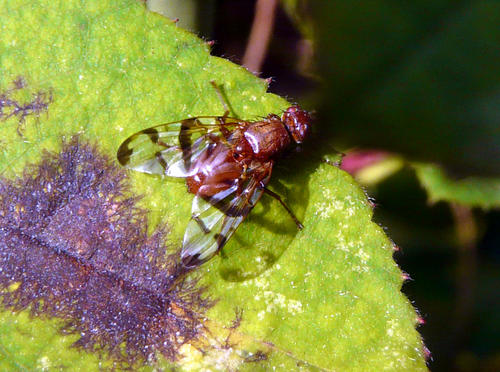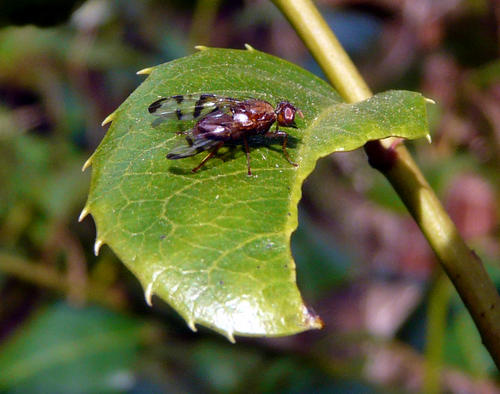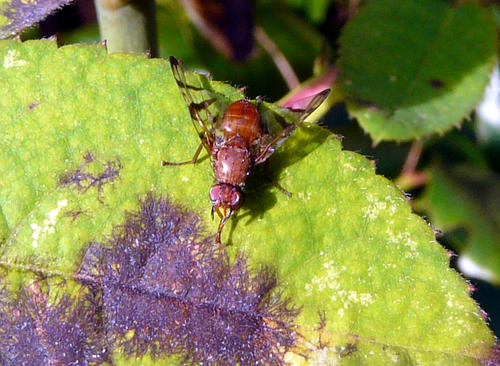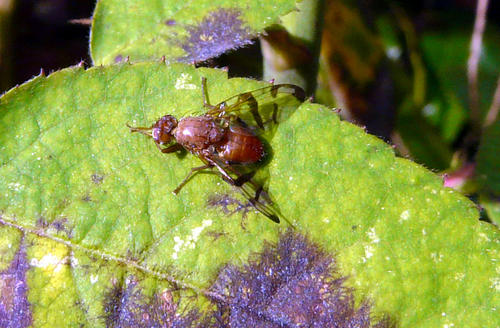Chetostoma curvinerve - a second record for VC37, Worcestershire
Brett Westwood
On 24th February 2011, the first mild and sunny day for several weeks, I noticed two orange flies on the leaves on an evergreen shrub Itea ilicifolia in my garden in Stourbridge. Their wings were patterned with dark stripes and blotches and they flicked them in a sideways motion while posturing in front of each other. They looked like picture-winged flies, but were larger than any I’d seen before in the garden. In addition, the time of year seemed odd.
I took a few photographs and began a web search. The website www.diptera.info has an extensive collection of photographs of picture-winged flies and one species, Chetostoma curvinerve, matched the ones in my garden. However they were described as local in the UK , so I was wary of plumping for a hasty identification.
I sent pictures of them to Harry Green and Rosemary Winnall, who promptly replied by brandishing and posting copies of the latest Dipterist’s Digest which contained an article by Laurence Clemons (2010) about Chetostoma curvinerve and its distribution in the British Isles. The records below are from his fascinating account.
Although the first record of Chetostoma curvinerve in the UK was in 1893 in Cornwall, there were no confirmed, captured records until the 1970s, and a review by Steven Falk in 1991 of scarce and threatened flies of Great Britain cited just half a dozen post-1960 sites, in Cornwall, Hampshire, Dorset, Sussex and Surrey. In the late 1990s, more records came from the south-east plus others from Glamorgan (Swansea), Somerset and the Isle of Wight. In the first decade of the 21st century there were more records including the first and only record from Worcestershire on April 17 2003 of one visiting a moth trap in Ribbesford Wood, near Bewdley. By the end of October 2010 there were 57 records of Chetostoma curvinerve from 39 sites in 39 10-kilometre squares, most in the south and south-east. Private gardens and cemeteries accounted for two-thirds of these. Alan Stubbs,an expert dipterist, has since confirmed my identification.
Clearly this fly is on the move, but mysteries remain. It is often seen on the leaves of evergreens such as holly, ivy and rhododendron, possibly because they warm up well in early spring and make broad jousting platforms. Most records are from February until May, with a gap in midsummer and then a scattering in late summer and early autumn. Its food-plant is unknown , but close relatives are associated with honeysuckle Lonicera and it is possible that the larvae develop in the berries. Alan Stubbs (pers comm.) thinks that the fruits of cherry plum Prunus cerasifera are a possible host. Clemons (2010) suggests that maturing ivy berries in spring when most adults have been seen might point to them as a larval food, but as yet there is no proof. Cherry plum, ivy and honeysuckle are a few metres from my sightings.
Identifying Chetostoma curvinerve is relatively simple as few picture-winged flies of its size (7mm long), have a bright-tawny orange body and a similar wing pattern which includes a dark wing-tip and a diagonal line reaching almost entirely across the forewing. In addition, the males have very distinctive dark curved spines guarding the mouthparts. The time of year and location is also a guide. A test key by Alan Stubbs has proved useful in determining the species.
References
Clemons, L. 2010. Chetostoma curvinerve (Rondani) (Diptera, Tephritidae) in Britain. Dipterists Digest, 17, No. 2, pages 83-98.
Stubbs, A. Test keys to Tephritidae. Version 31 Mar 2009
Images
Fig. 1. Chetostoma curvinerve in Stourbridge. Picture ©Brett Westwood
Fig. 2. Chetostoma curvinerve in Stourbridge. Picture ©Brett Westwood
Fig. 3. Chetostoma curvinerve in Stourbridge. Picture ©Brett Westwood
Fig. 4. Chetostoma curvinerve in Stourbridge. Picture ©Brett Westwood



